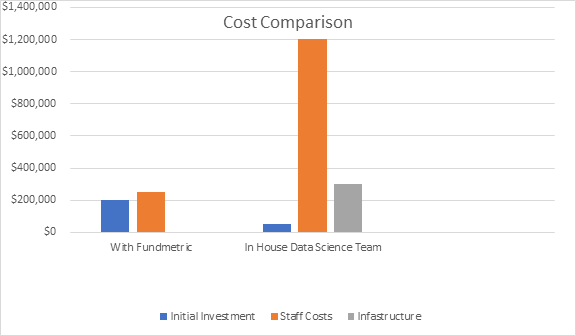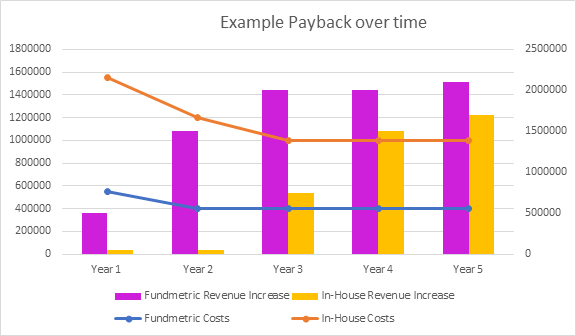The following content contains forward looking statements that have been generalized for illustrative purposes. This content is meant to give a sense of the return on investment with Fundmetric, and some of the key considerations when evaluating different solutions. This should not be interpreted to set exact expectations for your organization, as every organization is unique.
Artificial intelligence investment is becoming increasingly popular, and businesses and nonprofits are rushing towards the implementation of A.I. across the board. There are many complex return on investment (ROI) calculations available, but here are two common lenses of how to approach ROI on A.I. with Fundmetric:
- How much more can Fundmetric raise my organization?
- How much can Fundmetric save the organization?
Costs – The investment in resources to bring in profit. High costs of development and the time it takes to recruit talent will influence your ROI. There is the cost of team, licenses, security, platforms, algorithm, model design, building data infrastructure, etc.
Savings – Reducing Costs through better targeting, the elimination of systems and the ability to invest in adaptable and evolving frameworks.
Soft profits – There are many benefits of an AI project outside of hard costs and savings. With the support of AI, you can improve your organization’s decision making in countless areas, for example, donor retention, donor upgrades and increased donor activation, and this can lead your organization to increased profits later.
Goals and KPIs – As an organization goes through the process of implementing AI and generating the data that you will need for AI to be successful, they discover that teams whose processes were considered independent of, or invisible to other departments, become extremely important. This cross-collaboration leads to the creation of new KPI’s outside of standard practice.
For large enterprises Fundmetric can take approximately 6-24 months to obtain a positive and consistent ROI and can be accelerated or decelerated by an organization’s adoption.
ROI: How Fundmetric Increases fundraising
The ROI will vary depending on the size, scope and capacity of the teams who adopt Fundmetric, but can roughly be calculated depending on the following factors:
- New prospects identified and converted using Fundmetric predictions
- Lift in reactivation of annual donors by Fundmetric digital and analog channels
- Upgrades in annual donors to leadership giving and major gifts
- Prevention of attrition
- Recapture of lost donors using Fundmetric’s abandon cart technology
- Savings in infrastructure and hard (mailing etc.) costs due to Fundmetric targeting
- Increased Staff productivity and efficiency due to Fundmetric’s customized workflows
Fundmetric’s “Major Donor Prediction in the Next 12 Months” alone is likely to produce a positive 2x-5x ROI for a qualified customer, however this can be accessed during our pre-partnership discussions.
ROI: Fundmetric Compared to In-House Implementation
- The cost of implementing in-house solutions.
- The cost of maintaining and changing in-house solutions
- The cost of buying third party tools to build and maintain ecosystem
- Time to build infrastructure
- Time to develop and train accurate models
(The figure below shows a cost comparison on implementing an in-house solution vs Fundmetric and is for example purposes only. The staff costs bar illustrated above “With Fundmetric” is staff time spent implementing and using the platform, the staff costs illustrated above “In-House Data Science Team” is building, integrating and using their solution)

(The figure below is designed to demonstrate the payback period of ROI with Fundmetric and is for example purposes only. The revenue increases and costs are designed to illustrate proportions, not absolute numbers. Numbers can be much higher or lower depending upon adoption and organization size)

According to Glassdoor, the average salary of a data scientist is $114,000 USD per year and Mickinsey predicts a deficit of 250,000 data scientists. Some research is now predicting that a company could require 20 data scientists to deliver projects.
There are further human costs in the areas of analytics, and database administrators needed to successfully implement an AI project, and build AI driven infrastructure. There is also substantial ramp up time in getting teams up to speed, and the costs and availability of server and compute power are also factors.
The compute power required for data science projects is no longer a small cost, and the increased need for compute power means demand will outpace supply. While some institutions, particularly in higher education, will have access to their own compute power, internal demand may de-prioritize fundraising.
Another approach that can be considered is using internal talent such as computer science departments. This can work, but the specialization required to understand fundraising often takes years to develop and depends on people not changing jobs. The turnover that impacts an internal project and lack of institutional knowledge retained can be problematic.
A final threat to consider is that all this work can be done, for the data science team to discover that they don’t have the data or information they need to achieve their outcomes. Fundmetric has mitigated this threat by providing the infrastructure that addresses the lack of data.
In Conclusion
Many of our clients have reported that they feel we are an extension of their staff and an outsourced data science team, this results in access to:
- Talent that would be cost prohibitive
- Active academic research in the area of fundraising
- A shared community that allows for an evolving ecosystem
Important to understand, is that with Fundmetric you are not buying a product, but a partnership with people who have developed a platform. Organizations that enter into an AI partnership knowing that it is a journey and not a destination, and do so as part of their digital transformation, are the most likely to succeed. AI can have a transformative impact on your organization, and you should be able to count on a partner that makes your return on your investment a top priority.
Bio: Kristopher has over 18 years of marketing experience in both Canada and the USA and 8 years experience in fundraising for Canadian charities. With an emphasis on multi-channel direct marketing, Kristopher has managed over $7 million dollars in annual donations integrating direct mail, digital including predictive modelling, face-to-face and telemarketing strategies to drive growth and lifelong donor journeys.
“The concept of digital fundraising today must include predictive modelling/machine learning. Including machine learning in the mix ensures that you’re driving down your cost of funds raised while ensuring that no donor feels overlooked because you’re providing meaningful, personalized stewardship touch points at the right time in their donor journey.”
-Kristopher Gallub, Fundmetric Fundraising Liaison


.png)